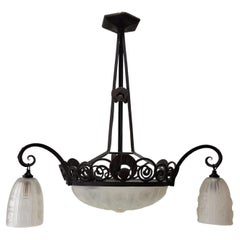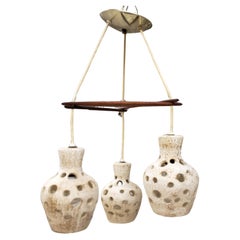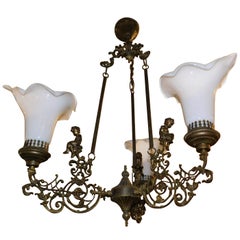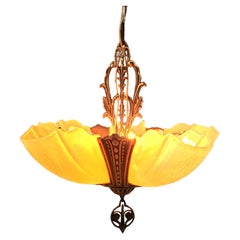Want more images or videos?
Request additional images or videos from the seller
1 of 18
Art Nouveau Chandelier with Quezal Shades
Price:$1,050
$2,200List Price
About the Item
- Creator:Quezal (Maker)
- Dimensions:Height: 30 in (76.2 cm)Diameter: 15 in (38.1 cm)
- Style:Art Nouveau (Of the Period)
- Materials and Techniques:
- Place of Origin:
- Period:
- Date of Manufacture:circa 1910
- Condition:One of the shades has a small chip on the neck but you don't see this as it sits inside the shade holder.
- Seller Location:Hamilton, CA
- Reference Number:1stDibs: LU1355210556543
About the Seller
5.0
Platinum Seller
Premium sellers with a 4.7+ rating and 24-hour response times
Established in 2010
1stDibs seller since 2015
1,345 sales on 1stDibs
Typical response time: 1 hour
Authenticity Guarantee
In the unlikely event there’s an issue with an item’s authenticity, contact us within 1 year for a full refund. DetailsMoney-Back Guarantee
If your item is not as described, is damaged in transit, or does not arrive, contact us within 7 days for a full refund. Details24-Hour Cancellation
You have a 24-hour grace period in which to reconsider your purchase, with no questions asked.Vetted Professional Sellers
Our world-class sellers must adhere to strict standards for service and quality, maintaining the integrity of our listings.Price-Match Guarantee
If you find that a seller listed the same item for a lower price elsewhere, we’ll match it.Trusted Global Delivery
Our best-in-class carrier network provides specialized shipping options worldwide, including custom delivery.You May Also Like
Quezal Art Nouveau Lamp
By Quezal
Located in NANTES, FR
Art nouveau lamp circa 1910.
Brass and copper base.
Iridescent glass tulip signed Quezal.
In perfect condition and electrified.
Total height: 38.5 cm
Base diameter: 15.5 cm
Width: 30 cm
Quezal Art Glass
Quezal Art Glass – The Journal of Antiques and Collectibles – April 2003
By Malcolm Mac Neil
Some of the most beautiful and alluring art glass made in America during the early part of the 20th Century was made by the Quezal Art Glass and Decorating Company. Often in the shape of blossoming lilies with brilliant gold interiors and colorfully decorated with floral and other motifs inspired by nature, Quezal art glass ranks right alongside the iridescent glass of Louis Comfort Tiffany and Frederick Carder. Quezal artisans created an extensive range of decorative and useful items, including vases, compotes, finger bowls, open salts, candle holders, and shades for lighting fixtures, which are equivalent in terms of beauty and quality of craftsmanship to Tiffany’s Favrile and Carder’s Aurene glass. In recent years, glass collectors have discovered anew the special charms and appeal of Quezal art glass, and collector desirability for this lovely glassware has increased dramatically.
The Quezal Art Glass and Decorating Company was incorporated a century ago, on March 27, 1902. It was founded by Martin Bach, Sr., Thomas Johnson, Nicholas Bach, Lena Scholtz, and Adolph Demuth. The factory was located on the corner of Fresh Pond Road and Metropolitan Avenue in Maspeth, Queens, New York. In October 1902, the trademark “Quezal” was successfully registered. By 1904, roughly fifty glassworkers were employed at the works.
Martin Bach, Sr. was the president, proprietor, and guiding force behind this successful company. Born in 1862 in Alsace-Lorraine to German parents, he emigrated to the United States in 1891. Before his emigration, Bach worked in Saint-Louis, France, at the Saint-Louis Glass Factory. After Bach arrived in this country, he was hired by Louis C. Tiffany as the latter’s first batch-mixer or chemist at the newly established Tiffany Glass and Decorating Company, in Corona, Queens. After a period of about eight years, Bach left Tiffany and established his own glassworks. By this time, Bach had already started his small family. He and his German-born wife, Anne-Marie Geisser, whom he married in the fall of 1889, in Paris, France, had three children. Two daughters, Jennie and Louise, were born in France and a son, Martin, Jr., was born in Corona.
Bach was assisted by Thomas Johnson, an English immigrant, and Maurice Kelly, a native of Corona, both of whom were gaffers or master glassblowers. Johnson and Kelly helped pave the way for Quezal’s early accomplishments and later recognition. Thomas Johnson, like Bach, was a founding member and also previously employed by Louis C. Tiffany. Johnson’s association with Quezal, however, was relatively short lived. Around 1907, Johnson left for Somerville, Massachusetts, where he became involved in making Kew Blas glass, under William S. Blake at the Union Glass Company. Maurice Kelly’s tenure with Quezal was also brief. Kelly worked at Quezal from January 1902 until July 1904, but by November 1904, he was making Favrile glass at Tiffany Furnaces, where he would happily remain until 1918.
To this day, the belief still exists that there once existed a man named Quezal, who worked for Louis C. Tiffany, and it is after him that Quezal glass is named. In truth, however, the founders of the Quezal Art Glass and Decorating Company named the company and its products after one of the world’s most beautiful birds, the elusive and rare quetzal, which dwells in the treetops of the remote tropical forests of Central America. A rare company promotional brochure provides a vivid description of the quetzal: Of all the birds of the America’s, it is the most gorgeous. No more splendid sight is to be seen in all the world than a quezal, flying like a darting flame through the depths of a Central American forest. Its back is of a brilliant metallic green, so vivid it shines even in the twilight of the woods like a great emerald and its breast is a crimson so deep and bright that every motion of the wonderful creature is a flashing of rubies among the trees and giant creepers. It bears a true golden crown upon its head – a helmet of bright yellow and green, shaped just as the helmet of old Aztec kings were shaped. Its tail is composed of lacelike plumes, extending more than two and one-half feet beyond its body.
The quezal was certainly an appropriate designation for the company’s resplendent glassware. One of the most prized characteristics of Quezal art glass is the shimmering and dazzling brilliance reflected in the iridescent surfaces on the interior as well as exterior of the glass. The radiant rainbow colors in metallic hues, including gold, purple, blue, green, and pink, to name only a few, were certainly inspired by the quetzal and its feathers. Not surprisingly, lustrous feathers, in shades of opal, gold, emerald, and blue, are among the most common decorative motifs encountered on Quezal glass.
The enduring hallmark of Quezal art glass is its unique expression of the Art Nouveau style, based on organic shapes and naturalistic motifs coupled with technical perfection in the execution. Vases, compotes, drinking vessels, and shades for lighting fixtures were often fashioned to resemble flowers such as crocuses, tulips, calla lilies, casablanca lilies, and jack-in-the-pulpits. Variously colored inlaid threads of glass, pulled and twisted by hooks, simulate naturalistic floral and leaf patterns, lily pads, clover leafs, and vines. Opal, gold, and green colors prevail and the glass is generally opaque. Red is the rarest color of all. Compared with Tiffany’s Favrile glass, the crisp, vivid, and colorful decoration of Quezal art glass is distinctively precise, symmetrical, and restrained.
Other Quezal wares recall shapes and styles favored in ancient Egypt, Persia, Greece, and Rome, as well as the Italian Renaissance and the Georgian period in England. This is especially true of classic-shaped vases and bowls of translucent amber glass, which have a single surface color such as iridescent gold or blue. Still, others were inspired by traditional Chinese and Japanese forms.
The Gorham Manufacturing Company in Providence, Rhode Island, and the Alvin Silver Manufacturing Company in Sag Harbor, Long Island, purchased Quezal art glass, which they in turn embellished in their shops with silver overlay decoration in the fashionable Art Nouveau style and later resold. Gorham’s silver overlay designs mostly include stylized floral motifs. Alvin’s silver designs are wonderfully organic. One sumptuous design is of a group of sinuous iris blossoms with carefully articulated petals surrounded by attenuated meandering vines. Collectors should note that not all silver-deposit pieces are marked with a maker’s mark since the silversmith had to be quite careful not to damage the glass underneath.
A rare 1907 retail catalog survives from Bailey, Banks, and Biddle Company, a luxury goods retailer in Philadelphia, which reveals original retail prices of Quezal art glass. A surprising revelation provided by this catalog is that Quezal art glass was nearly twice as expensive as comparable French imported glass made by such renowned firms as Gallé and Daum. Hock glasses, a stemmed glass used primarily for drinking German white wine, were sold by the dozen and retailed between $50 and $75. Fingerbowls were also sold by the dozen and retailed between $50 and $100. These high retail prices were nearly the same as those charged for Tiffany’s Favrile glass, and suggest Quezal art glass was also marketed towards the high-end or luxury market.
Electricity was a brand new invention in the late 1800s and American glass manufacturers developed novel approaches for concealing the electric light bulb, which was rather harsh to the eye and perhaps unflattering to the domestic interior. Tiffany, Steuben, and Quezal responded to this need with the most extraordinary and beautiful art-glass shades, all of which were hand-made and exquisitely fashioned. Many other companies also made art glass shades for table and floor lamps, electroliers, hallway fixtures, and wall sconces, but it was Quezal that excelled in this area and was the most prolific.
Quezal art glass shades were available in an infinite variety of shapes, sizes, colors, and decorations. Some shades are formed and decorated as lilies while others are bell-shaped and have ribbed or textured decoration. Rims are usually plain but sometimes are notched or ruffled. Common motifs include feather or hooked feather, leaf and vine, applied flowers, drape, fishnet, King Tut, and spider webbing. The workmanship shown on most Quezal shades...
Category
Vintage 1910s French Art Nouveau Table Lamps
Materials
Brass, Copper
Quezal Art Glass Fixtures (3)
By Quezal
Located in Bronx, NY
This interesting group of three vintage bronze flush mount ceiling fixtures dates from the 1920’s. Each sculptured bronze fixture features stylish decoration & holds a beautiful bell...
Category
Vintage 1920s American Art Deco Chandeliers and Pendants
Materials
Bronze
Three Quezal Lampshades
By Quezal
Located in London, GB
Three iridescent firm glass pattern shades.
In good condition. One shade has a minor chip on rim, which would be covered by the cap. See photos, chip on display there.
Other two, go...
Category
Vintage 1970s American Chandeliers and Pendants
Materials
Blown Glass
Large & Organic Design Bronze Art Nouveau Chandelier with Glass Flower Shades
Located in Lisse, NL
Rare and beautiful Art Nouveau, three light pendant light.
This rare and wonderfully stylish Art Nouveau pendant dates from the earlier days of European, indoor lighting. This larg...
Category
Early 20th Century French Art Nouveau Chandeliers and Pendants
Materials
Brass, Bronze
$5,415
Free Shipping
H 40 in Dm 21.5 in
Bronze Medieval Gothic Dragon Chandelier w/ Quezal Gold Iridescent Shades
Located in Van Nuys, CA
A rare and extraordinary chandelier featuring four finely cast bronze dragons with dramatic wings and intricate detailing. Each dragon clasps a lantern-style shade of American Quezal...
Category
Vintage 1920s American Edwardian Chandeliers and Pendants
Materials
Bronze
$26,250
H 16 in W 24 in D 24 in
Art Nouveau Brass and Bronze Five-Light Chandelier with Frosted Glass Shades
Located in Barntrup, DE
This beautiful French Art Nouveau chandelier features a brass central body and five arms, made of bronze and richly decorated with roses and rose leaves. Each arm has a white frosted...
Category
Vintage 1930s French Art Nouveau Chandeliers and Pendants
Materials
Brass, Bronze
$1,191
H 33.47 in Dm 27.96 in
Art Nouveau Art Glass Grape Pendant Light with 2 Shades
Located in Riverdale, NY
Lovely Art Nouveau Art Glass Grape Pendant Light of European origin with 2 sets of art glass grape clusters in yellow and uranium green glass. Elab...
Category
Antique Early 1900s French Art Nouveau Chandeliers and Pendants
Materials
Brass
$2,280 Sale Price
20% Off
H 23 in W 7 in D 7 in
Antique 5 Arm Art Nouveau Bronze Chandelier w/ 5 Handblown Vaseline Glass Shades
Located in Petaluma, CA
This high quality bronze chandelier is highlighted with 5 original hand blown vaseline glass shades.
The bronze work is nicely detailed with a leaf pattern. The glass shades perf...
Category
Early 20th Century American Art Nouveau Chandeliers and Pendants
Materials
Bronze
$4,800
H 39 in Dm 13.75 in
Art Nouveau Chandelier
Located in Atlanta, GA
A very Fine Art Nouveau chandelier. Exquisite bronze work. Art glass globe and shades.
Dimensions:
H 30.5"
D 17"
5 lights
CW3956.
Category
Early 20th Century French Art Nouveau Chandeliers and Pendants
Materials
Bronze
7 Arm Art Nouveau Bronze Chandelier, American circa 1900, Original Mica Shades
Located in Petaluma, CA
This exceptional 7 light chandelier is one great light. It has much to offer. For starters it is American, and you don't see much commitment to art nouveau lighting...
Category
Early 20th Century American Art Nouveau Chandeliers and Pendants
Materials
Bronze, Other
$7,500
H 25 in W 17 in D 17 in
More From This Seller
View AllFrench Art Deco Wrought Iron and Cased Glass Chandelier
Located in Hamilton, Ontario
French Art Deco chandelier featuring a floral themed relief frosted glass bowl in the center and three matching shades. It has a highly stylized wrought iron frame with sleek geometr...
Category
Vintage 1920s French Art Deco Chandeliers and Pendants
Materials
Wrought Iron
West German Mid-Century Triple Pendant Art Pottery & Teak Bracket Chandelier
Located in Hamilton, Ontario
This art pottery chandelier is unsigned, but presumed to have originatd from West Germany and date to approximately 1965 and done in the period Mid Century Modern style. The shades a...
Category
Mid-20th Century German Mid-Century Modern Chandeliers and Pendants
Materials
Wire
French Figural Bronze Chandelier with Italian Putti's Cherubs, circa 1910
Located in Hamilton, Ontario
Early 20th century French bronze figural chandelier with 3 cherubs or Putto. Three hand blown milk glass shades have been replaced wit...
Category
Early 20th Century French Chandeliers and Pendants
Materials
Bronze
Art Deco Five Light Slip Shade Chandelier Ceiling Fixture by Crown Lighting Co.
Located in Hamilton, Ontario
This antique chandelier was made by the Crown Lighting Company of the United States and dates to approximately 1920 and done in the period Art Deco style. The fixture is made of cast...
Category
Early 20th Century American Art Deco Chandeliers and Pendants
Materials
Iron
Antique Art Nouveau Iridescent Art Glass Vase with Enamel Floral Decoration
Located in Hamilton, Ontario
This antique art glass vase is unsigned, but presumed to have originated from Austria and date to approximately 1900 and done in the period Art ...
Category
Early 20th Century Austrian Art Nouveau Vases
Materials
Art Glass
Kayserzinn Art Nouveau Pewter Pitcher with Devils Head
By Kayserzinn 1
Located in Hamilton, Ontario
German Kayserzinn pewter wine/water pitcher or jug with Art Nouveau style low relief iris decoration centered by a Devils head under the spout and a ...
Category
Early 20th Century German Art Nouveau Urns
Materials
Pewter
Recently Viewed
View AllMore Ways To Browse
Quezal Glass
Quezal Art Glass
Pulled Feather Lamp
Quezal Shades
Quezal Art Glass Shades
Austrian Glass
Glass Shades
Used Light Fixtures
Circa Lighting
Used Lighting Fixtures
Pendant Lighting Black And Brass
Italian Iron Furniture
Italian Art Deco Furniture
1939 Lighting
Vintage Danish Lighting
Czech Republic Glass
Vintage Candelabra
Vintage Candelabras



